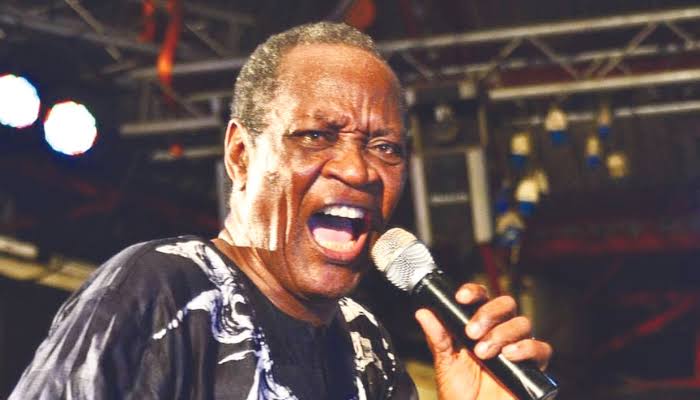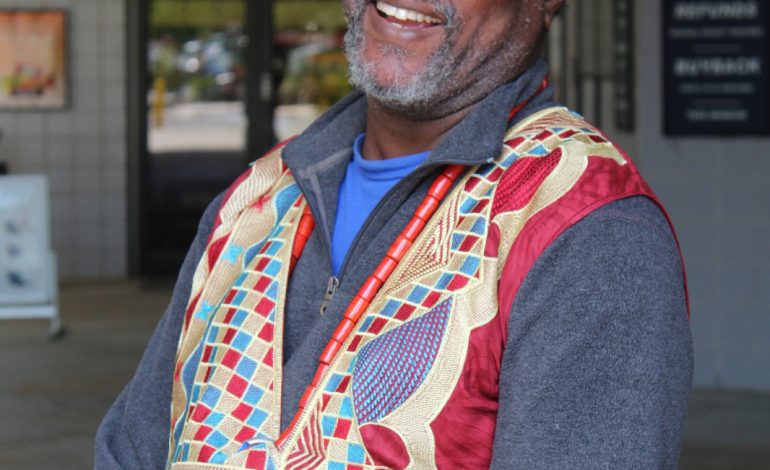Jimi Solanke and Wole Soyinka: From ‘Ear of State via 5th Aweri and the Ogbu of Gbu to Elesin Oba and Beyond…’

By James Gibbs
THE death of Jimi Solanke on the 4th February, 2024, sent long-term observers of Nigeria’s cultural scene reflecting on the remarkable career of a much-loved stage personality. Among the appreciative articles published were several that drew on long and close acquaintance. One strand in the Solanke story concerns his work with Wole Soyinka that was particularly intense between 1960 and 1976. It may be said that he served an apprenticeship with Soyinka and offered him a masterpiece. During those years, Solanke acted in productions by Soyinka, accumulated relevant experience and grew as a performer. The young graduate of the Diploma Course in the School of Drama at Ibadan matured into a remarkable actor capable of taking on the most demanding roles, and equipped himself to become a versatile performer.
Thanks to Soyinka’s publications, and other hard-copy sources, a sense of the growth of the performer can be sketched in. This brief investigation of part of Solanke’s formation might be given the title, From Menacing Left Ear of State via the Fifth Aweri and the Ogbu of Gbu to the Elesin Oba and Beyond. Along the way, the biographical notes illuminate points of social history, theatre history and political history.
Relevant ‘hard-copy’ sources for Solanke’s early work in my ‘occasional theatre archive’ include Soyinka’s Ibadan, the Penkelemesi Years, a Memoir: 1946-1965, newspapers and theatre programmes from the 1960 to 1976 period along with missed and mourned West Africa magazine. In Ibadan, the memoirist mentions Solanke as amongst the ‘fledglings’ involved in the staging of A Dance of the Forests (1960).
Soyinka does not indicate the role Solanke took or the back-stage function he performed, but he includes him in the troupe and that inclusion provides a starting point. Soyinka’s list of members of the 1960 Masks, in which some names are glossed, provides an opportunity to note the company Solanke was keeping.

Late Jimi Solanke
A Dance of the Forest was staged by the 1960 Masks in Lagos and Ibadan in October, 1960 and those involved in the production included:
Patrick Ozieh, a petroleum engineer; Olga Adeniyi-Jones, of a long-indigenised ‘expatriate’ line, and an accomplished contralto; Ralph Opara, Yemi Lijadu, Segun Olusola, all broadcasters; Funmi Asekun, of ample proportions, who soon abandoned stage appearances but continued to effectively ‘mother’ the company; Francesca Pereira, of an old Brazilian stock, a melifluous [sic] soprano … Gaius Anoka, a schoolteacher, as was Dapo Adelugba … Then the fledglings, Tunji Oyelana, Femi Fatoba, Sola Rhodes, Yewande Akinbo, Segun Sofowote, Femi Euba, Wale Ogunyemi, Jimi Solanke and others who would form the core of the new Orisun Theatre, less the ones that got away … (Ibadan, 69-70.)
During the sixties, Soyinka complemented major stage productions with 1960 Masks by working in a revue format with a new drama group, Orisun Theatre, that, it was envisaged, would become professional. In the revues, performing irreverent, hard-hitting sketches, Solanke emerged as an actor and singer. I have not found any references to his participation in the first Orisun Theatre revue, The Republican (March, 1963), but that may be because my documentation is particularly thin at that point. I can see that he was deeply involved when that show was resurrected, changed and re-staged – a typical Soyinka procedure – some six months later and just after Nigeria had become a republic.
In the programme for The (New) Republican (November 1963), we read that the sketch ‘CRISIS!!!!!!!!!!!!’ was performed by ’Jimi Solanke, Yomi Obileye, Sonny Oti, Wale Ogunyemi, Tunji Oyelana, Eddy Fatoba, (and) Yemi Ogunbiyi’ – by, that is to say, a significant cohort of Orisun Theatre talent with some of whom Solanke was destined to have long, creative connections. Of the several crises in Nigeria in the run up to the performance I think, following Frank Aig-Imoukhuede’s article in The Daily Express of 11th March, 1964, that the one that prompted this sketch had to do with ‘food difficulties during a conference of African statesmen’. The newspaper reference includes: “But does the cook always end up with the ‘man in charge’ stamping on his unconscious body when it lies in a faint?” Perhaps significantly, no one is credited with the authorship of this sketch. Like some of the others, it may have been built on physical rather than verbal comedy.
Moving on through the programme for The (New) Republican, we come to ‘ART CLASS’ that was credited to ‘WS’ and for which the programme provided relevant political background. Briefly, the sketch commented on the creation of a fourth Region – the Mid-West – from parts of the Western Nigerian. Provinces were, it seems, amalgamated to form a new state with its capital in Benin City: three had become four.
In ‘ART CLASS’, the challenges posed by this new administrative arrangement were subjected to scrutiny. The programme note on the sketch read as follows:
Today’s theme – Trinity.
The subtle imagination of our artists can be seen in the frescoes and public monuments where the principal of ‘A bit of each’ is rigidly upheld – shall we call it? – the artistic trinity. But a new problem has arisen – what happens to the numerous reliefs, plaques, etc. now that they are confronted with a new unit? Will they now evolve a quartet symbol? We offer them an obvious solution.
This ‘obvious solution’ was acted out by “Yomi Obileye, Sola Akinsanya, Jimi Solanke, Wale Ogunyemi, (and) Elow Gabonal.” That list includes some of ‘the usual suspects’, and it is helpful to know that Soyinka hovers behind ‘Elow Gabonal’ that he has used as both a nom de plume and, as here, a stage name. Soyinka worked with Solanke in various ways. On this occasion, they were in the same sketch.
Soyinka’s genius for writing revue sketches – and for inspiring and shaping the group improvisation that sometimes resulted in sketches – led to the staging of another revue: Before the Blackout. This was put on in Lagos and Ibadan during March/April 1964, and Solanke was deeply involved. For example, he featured with Tunji Oyelana in the performance of the songs – or ‘musical productions’ – that opened and closed some of the shows. These can be linked to ‘glees’ and established a connection between Orisun performances and expectations encouraged by Yoruba Travelling Theatre troupes. As we might anticipate, given Soyinka’s determination to create engaged theatre, both ‘The Ballad of Traditional Philosophy’ and ‘The Ogbu of Gbu’ were overtly political. The latter, based on ‘The Vicar of Bray’, revealed the satirist’s affinity with the 18th Century English traditions that he had responded to when an undergraduate at the University of Leeds (1954-57).
Solanke also continued acting. A moment from a performance of the sketch, April Fools’ Ship is caught in a photograph in the published text of Before the Blackout (Orisun Acting Editions, n.d.) and shows an actor in flowing robes (presumably Tafewa Balewa) paddling a ‘boat’ inscribed ‘APRIL FOOLS’ SHIP, towards a second actor (Solanke?) wearing a hat with a feather stuck in the side – perhaps Festus Okotie-Eboh. The picture is captioned:
Scene from April Fools’ Ship, adventures of the Ministerial boat. Too ‘well-lined’ to be easily scuttled, it finally capsized from over-loading.
The episode this sketch alludes to is the subject of a paragraph beginning on page 200 of the Methuen edition of Ibadan that is worth reading for the political background and for a vivid account of the feathers it ruffled. However, to return to Solanke, and his involvement in Soyinka productions is to find him a year or so after Before the Blackout playing the Left Ear of State in the premiere of Kongi’s Harvest (August, 1965). That was a modest role but one that had to be played with silent menace. For the ‘revival’ of that play – resurrected, changed and re-staged (October, 1966), Solanke played the Fifth Aweri. The ‘fledgling’s’ promise had been recognised: he was entrusted with ‘lines’ and given a part with some complexity.
After Kongi’s Harvest, Solanke’s name next jumps from my collection of cuttings some 10 years later when, in 1976, he created the monumental role of Elesin Oba in Death and the King’s Horseman. Thanks to Gerald Moore, who reviewed the University of Ife production for West Africa (10th January, 1977), we have a vivid account of Solanke’s outstanding portrayal. Moore wrote as follows:
Fortunately Jimi Solanke, who has to carry the bulk of the play in the role of the Elesin, turned in what must be the performance of his life. His expressive body and eloquent dancing were matched by a voice of great range and flexibility. Not a word was lost, and each word in the right verbal texture of this beautiful play was made to work within our understanding.
History was made by that production and that performance, and the ‘rest is history’ too. Some of it, like that reported above, is social history; some theatre history and some political history. It is to be hoped that appreciations of the life and work (the personal history) of Jimi Solanke will trace in greater detail the trajectory of the actor who, between 1963 and 1976, was transformed from a menacing Ear of State into a multi-faceted Elesin Oba and who still had nearly fifty years to live and create. Though the above draws on fragmentary evidence, it hints at the way the fledgling Jimi Solanke grew his wings. By 1976, he was fully fledged and ready to soar on the winds!
* Gibbs wrote in from Bristol, UK



